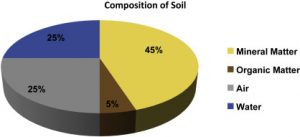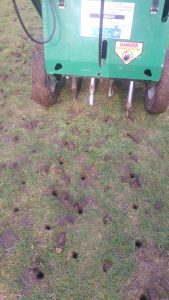When water doesn’t easily drain through the soil of your lawn it can become saturated. Let’s take a look at what to do when your lawn becomes waterlogged.
Why is my lawn waterlogged?
Your lawn soil should be 25% air, 25% water, 45% minerals (sand, clay etc) and 5% decomposing organic matter. This balance helps to keep your soil healthy. The organic matter is broken down by soil organisms and they need air and water to do this – they are alive after all! The organic matter is made up of bits of dead insects, leaves and the like, that are taken into the soil by worms and beetles. As they digest the organic matter, the soil microbes excrete, and that excretion contains essential nutrition to help keep the soil healthy and the plants too.

The 25% air which makes up your soil is essential for life support. The grass plants need it to help their roots ‘breathe’. The soil microbes need it too. That air is stored in all the tiny gaps within the soil. Cracks that form and holes made by burrowing insects etc. Think of your soil like a sponge. The holes in the sponge are where the air is. The sponge itself can hold some water, but as that sponge takes on more water the air within it is expelled and water is held in its place instead. Your lawn soil is no different. As the 25% water starts to increase then the 25% air starts to…you got it…decrease. This imbalance can be very bad if it continues for any extended period of time.
Soil with less air is less able to support essential organisms that play an important part in maintaining healthy soil. Soil with less air also makes it harder for plants to function correctly and ‘breathe’ through their roots. As the soil becomes less healthy so do the plants that grow in that soil.
What can I do about a waterlogged lawn?
Waterlogging is more of an issue in soils that have a heavy clay content. In addition, lawns that are compacted will drain less easily. If you want to help your lawn to drain better, then you need to think about the soil composition and address any compaction.
Remember that it’s not a good idea to attempt to work on waterlogged soil so if you are looking to improve things wait until the lawn has dried out enough before you start.

Helping your lawn to drain
First of all, deal with any compaction. You can tell the areas that aren’t draining well and these need to be spiked or aerated to create cracks and gaps within the soil itself. The more often you do this the better. At least annually – however many golf courses will aerate on a monthly basis.
Mowing to improve lawn soil
Remember what we were saying about that 5% decomposing organic matter? Well, you can help improve your soil by mulch mowing – leaving clippings behind, to be taken into the soil and digested by soil microbes. Boosting soil microbes will help to aid drainage too. Getting mulch mowing right is important though, so check out how to do it before you start.
Improving soil to reduce waterlogging in lawns
In addition to aeration and mulch mowing, a compost-based topdressing blending with horticultural sand can be applied to help improve soil structure and boost microbial activity. It’s hard work and relatively specialist so speak with a lawn professional for advice.
Waterlogged lawn in new-build properties
Have you ever seen what a new housing development looks like whilst the build is underway? Usually top-soil is stripped off before building begins. All that heavy equipment can seriously compact the subsoil. When the build is complete some top-soil will be returned before turf is laid and the house sold. Only later is the compaction discovered when issues with lawn growth are identified. It’s hard work to put right and in some instance land drains may need to be laid to help with drainage.

 Established 2016
Established 2016



